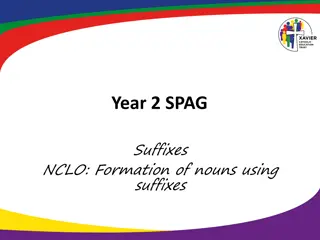Learning Adverbs, Comparatives, and Superlatives in English Grade 6 Lesson 3
Enhance your English skills in Grade 6 with Lesson 3 on adverbs of frequency, comparative and superlative forms, and possessive pronouns. Practice choosing the correct adverbs, filling in the gaps with adjectives, and mastering the use of quantifiers. Improve your language proficiency and expand you
8 views • 12 slides
Medical Terminology Health Science 20
Medical terminology is a specialized language used in healthcare to describe medical concepts concisely. It consists of prefixes, root words, and suffixes, which can be broken down to define complex terms. Utilizing proper medical terminology enhances communication among healthcare professionals and
3 views • 16 slides
Understanding Notional Parts of Speech: Adjectives and Adverbs
Exploring the notional parts of speech, this text delves into the properties and functions of adjectives and adverbs. Adjectives describe the qualities of substances, while adverbs characterize actions or qualities. Adjectives can be qualitative or relative, with degrees of comparison, while adverbs
1 views • 25 slides
Explore Suffix Rules Through Engaging Activities
Discover and practice suffix rules through interactive activities in this engaging PowerPoint presentation. Remember, apply the rules to create new words and reinforce your understanding. Join the fun learning journey with Owls and Badgers today!
0 views • 29 slides
Understanding Suffix Trees: A Comprehensive Overview
Explore the concept of suffix trees through detailed explanations, diagrams, and examples. Learn about tries, compressed tries, suffix tree construction algorithms, and more. Discover how suffix trees are used to efficiently store and search for substrings in a string.
1 views • 21 slides
Understanding Pronouns: A Comprehensive Guide for English Learners
Explore the world of pronouns with this detailed presentation created by Mr. Honglem from Grace Academy. Learn what pronouns are, discover their types including personal and possessive pronouns, and understand how to use them correctly in sentences. Engage in interactive practice exercises to enhanc
1 views • 22 slides
Transforming Adjectives into Adverbs by Adding the -ly Suffix
Explore the process of converting adjectives into adverbs by adding the -ly suffix. Understand how this simple change alters the meaning of words and enhances sentence construction. Engage in educational activities to practice this concept effectively.
0 views • 8 slides
Practice Exercises on Determiners
Enhance your understanding of determiners with a series of exercises. Fill in the blanks with articles (a, an, the), demonstrative/possessive determiners (this, that, my, our, etc.), and numeral determiners (one, some, many, etc.). Additionally, practice error correction tasks related to determiners
0 views • 5 slides
Analysis of "My Last Duchess" by Robert Browning
The poem "My Last Duchess" by Robert Browning portrays the Duke of Ferrara showcasing a painting of his late Duchess to a visitor. Through the Duke's words, we uncover his controlling and possessive nature, highlighting his manipulation and jealousy over the Duchess's innocent demeanor. The Duke's r
1 views • 19 slides
Understanding "My Last Duchess" by Robert Browning - Analysis and Interpretations
This analysis delves into the dramatic monologue "My Last Duchess" by Robert Browning, exploring themes of power, control, and possession through the Duke's chilling narrative about his late wife. The in-depth examination reveals the Duke's possessive nature, shedding light on societal expectations
6 views • 8 slides
All About Nouns: Types, Rules, and Examples
Explore the world of nouns - words that name people, places, things, or ideas. Learn about singular/plural, common/proper, concrete/abstract nouns, possessive/collective nouns, and rules for making singular nouns plural with helpful examples.
1 views • 22 slides
Large-Scale Sequence Alignment Techniques Overview
Lecture slides discuss key concepts, goals, challenges, and strategies for aligning long sequences, focusing on methods like suffix trees, dynamic programming, and pattern matching. The MUMmer system for finding maximal unique matching subsequences is explored along with examples of large-scale alig
0 views • 46 slides
Exploring Noun Formation with Suffixes - Year 2 SPAG Activities
Dive into the world of noun formation using suffixes in this engaging Year 2 SPAG lesson. Discover how suffixes transform verbs into nouns, identify job titles by adding the suffix "-er" to action words, understand emotions through "-ment" suffixes, and recognize qualities with "-ness" endings. Enga
0 views • 10 slides
Grammar Errors Correction Exercises for English Language Learners
Correcting grammatical errors is essential for students learning English. This content provides exercises where students need to identify and correct errors in given sentences. The errors include punctuation mistakes, subject-verb agreement, possessive forms, and spelling errors. By practicing these
1 views • 23 slides
Understanding Possessive Pronouns and Adjectives in Family Stories
Explore how possessive pronouns and possessive adjectives are used in family stories featuring the Yeung, Ching Yee Annie, Lee, Fung King Jackie, and Simpson families. Discover how pronouns replace repeated nouns to make storytelling more engaging and concise. Dive into narratives about family membe
0 views • 15 slides
Exploring Words with 'ped' - Creatures and Actions
Discover a variety of words related to creatures and actions that involve feet in this collection. From creatures like bipeds, centipedes, and millipedes to actions like pedicures and peddling, explore the meanings and images associated with the common suffix 'ped'.
0 views • 21 slides
Daily ELA Review Grade 3 - Week 31 & Week 32 Activities
Engage your third-grade students with daily ELA review tasks for Week 31 & Week 32. Practice possessive pronouns, past tense, possessive nouns, verbs, adjectives, conjunctions, and more through interactive exercises.
0 views • 48 slides
Understanding Possessive Nouns and Pronouns in English Grammar
Explore the usage of possessive nouns and pronouns in English grammar through examples of singular and plural possessive forms. Learn how possessive pronouns replace possessive nouns to indicate ownership effectively in sentences. Enhance your understanding of forming possessive constructions and ap
0 views • 10 slides
Interactive Word Study Lesson on Ants and the Animal Kingdom
Explore the fascinating world of ants and the animal kingdom through an interactive word study lesson. Discover focus words, suffix identification, compound words, and creating new words with prefixes. Engage students in hands-on activities to enhance language skills and understanding of word format
0 views • 7 slides
Advances in Full-Text Indexing Using Suffix Arrays
Explore the evolution of full-text indexing techniques leveraging suffix arrays, from SA-hash to FBCSA, with insights on experimental results, suffix trees, and compressed indexes like CSA and FM-index. Discover efficient search strategies and data structures for pattern matching in text processing.
1 views • 28 slides
Exploring RNA-Seq Read Mapping and Quantitation
Dive into the world of RNA-Seq expression analysis through topics such as read mapping, quantitation, and the challenges faced in short-read mapping. Discover the typical parameters, design pressures, and basic ideas behind suffix tree index construction for efficient handling of large reads and dat
0 views • 19 slides
Understanding Singular, Plural, and Possessive Nouns
Explore the basics of singular, plural, and possessive nouns with examples and guidelines on forming and using them correctly. Enhance your writing skills and grasp the concept of noun variations effortlessly.
0 views • 13 slides
Understanding Different Types of Pronouns
Learn about the seven types of pronouns - Personal, Possessive, Reflexive, Relative, Demonstrative, Indefinite, Interrogative. Personal pronouns replace nouns, possessive pronouns replace possessive nouns, reflexive pronouns refer back to the subject, relative pronouns introduce relative clauses, an
0 views • 16 slides
Understanding Pronouns: Complete Worksheet for Practice
This detailed worksheet provides comprehensive information on subject pronouns, object pronouns, possessive adjectives, possessive pronouns, and reflexive pronouns. It includes examples and exercises to help you understand and practice using pronouns correctly in sentences.
0 views • 15 slides
Understanding Possessive Pronouns and Their Usage
Possessive pronouns indicate ownership and possession, such as mine, yours, hers, and theirs. Learn more about possessive pronouns with examples and practice exercises to enhance your understanding. Discover how to identify possessive pronouns in sentences and improve your grammar skills.
0 views • 5 slides
Mastering -ed Suffix in One-Syllable Words
Learn how to add the -ed suffix to one-syllable words by doubling the last letter to maintain the short vowel sound. Engage in activities to practice spelling words like patted, hummed, and clapped. Enhance your skills through exercises and unscrambling tasks. Perfect your understanding of this spel
0 views • 8 slides
Understanding Verbal Categories of Tense in English and Arabic
Verbs in English and Arabic exhibit tense distinctions with different forms denoting past and present time. English has two tenses - past and present, marked by suffixes, while Arabic has perfect and imperfect tenses marked by suffixes, prefixes, and internal vowel changes. Contrasts include English
0 views • 24 slides
Understanding Possessive Pronouns and Contractions
Learn about possessive pronouns like its, her, his, our, and contractions such as it's, they're, who's, and the importance of correctly using them in writing to avoid errors. Practice examples to reinforce understanding.
0 views • 7 slides
Understanding Neoplasia: Characteristics and Nomenclature of Tumors
Neoplasia, or new growth, is characterized by uncoordinated growth exceeding that of normal tissues, persistent growth independent of stimuli, loss of responsiveness to growth controls, and local expansion regardless of host environment. Tumors are classified into benign and malignant categories in
0 views • 36 slides
Suffix & Prefix Practice Examples from Exam Boards
Practice adding suffixes and prefixes to root words in sentences from various exam boards to improve understanding and usage of word formations. Examples cover subjects like literature, politics, and wisdom, offering a diverse range of vocabulary to enhance language skills.
0 views • 10 slides
Understanding the Burrows-Wheeler Transform and Suffix Array
Explore the concept of the Burrows-Wheeler Transform and Suffix Array, key algorithms in data compression. Learn about the transformation process, suffix arrays, compression techniques like Bzip, and how to compute the BWT. Discover the significant role these methods play in efficient data compressi
0 views • 10 slides
Unpacking Identities: Hispanic, Latinx, and Ch/Xicanx
Delve into the complexities of Hispanic, Latinx, Chicano/a, and Xicano/a identities through the insightful exploration of language's power in serving marginalized communities like youth. Understand the impact of terms, the inclusivity offered by the "X" suffix, and the historical context behind Hisp
0 views • 16 slides
Common Writing Errors Every Student Should Avoid
Common writing errors can negatively impact your academic work. This article highlights 30 errors, such as misuse of the suffix "-wise," confusion between "type" and "kind," redundant phrases, and incorrect usage of "different" and "due to." It also covers distinctions between "disinterested" and "u
0 views • 13 slides
Understanding Plural and Possessive Forms in English
Learn the distinction between plural (-s) and possessive (-'s) forms in English nouns through examples and explanations. Discover how to form plurals, show possession, and distinguish between plural and possessive usage in sentences.
0 views • 8 slides
Understanding Present Continuous Tense and Verb Forms
The content discusses the Present Continuous Tense, consisting of the verb "be" and the suffix "-ing", its uses in describing ongoing actions at the moment of speaking, planned future events, temporary actions or habits, and expressing irritation. It also covers verb forms with examples and rules fo
0 views • 22 slides
Understanding IP Addressing in Computer Networks
IP addressing provides a seamless network for users by abstracting and providing a uniform addressing scheme used by higher-layer protocols and applications. IP addresses identify connections rather than specific computers, with IPv4 using 32-bit integers and IPv6 using 128-bit addresses. The divisi
0 views • 19 slides
Understanding the Structure of Medical Terms
Medical terms consist of word roots, prefixes, suffixes, and combining vowels rooted in Greek and Latin. Word roots provide the core meaning, prefixes modify it, suffixes indicate conditions, and combining vowels connect roots. Recognizing these elements aids in deciphering complex medical terminolo
0 views • 10 slides
Understanding Pronouns: Types and Usage
Pronouns are vital elements in language that replace nouns to avoid repetition and make sentences concise. They include personal, possessive, reflexive, intensive, indefinite, demonstrative, relative, interrogative, and reciprocal pronouns. Personal pronouns serve as subjects (e.g., I, he, she) or o
0 views • 18 slides
Pronouns and Possessives in English Grammar
Explore the various types of pronouns and possessives in English grammar, including personal pronouns, possessive adjectives, possessive pronouns, reflexive pronouns, and relative pronouns. Learn how to use them correctly in sentences and understand their roles in different contexts.
0 views • 20 slides
Analysis of 3SG Possessive Functions in Beserman Udmurt Corpus
Beserman Udmurt's 3SG possessive holds significance beyond typical possessive relations, often serving non-possessive functions like marking contrastive focus. This study delves into the diverse functions of the 3SG possessive in Udmurt through corpus analysis, exploring its evolution into a definit
0 views • 35 slides







































